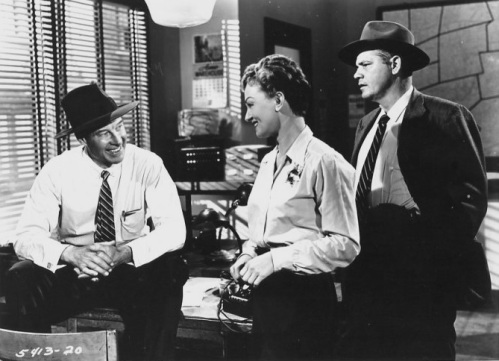
Directed by Harmon Jones
Produced by Leonard Goldstein
Written by George W. George and George F. Slavin
Director Of Photography: Charles G. Clarke, ASC
Musical Direction: Lionel Newman
Film Editor: George A. Gittens
CAST: Jeanne Crain (Linda Culligan), Dale Robertson (Brett Stanton), Richard Boone (Johnny Ringo), Lloyd Bridges (Gar Stanton), Carole Mathews (Cynthia Castle), Carl Betz (Phil Ryan), Whifield Connor (Jim London), Hugh Sanders (Bill Gifford), Rodolfo Acosta (Mendoza), Pascual Garcia Pena (Pig), Don Haggerty (Bob Thrailkill), Leo Gordon, John Doucette, Frank Ferguson, James Best.
__________
On March 17, 1897, in Carson City, Nevada, Bob Fitzsimmons knocked out “Gentleman” Jim Corbett in 14 rounds to become the World Heavyweight Champion.

This historic boxing match is the basis of City Of Bad Men (1953), as bandits are drawn like flies to the event’s box office. Among those ambitious outlaws are Brett Stanton (Dale Robertson) and his outfit, which includes his brother Gar (Lloyd Bridges), along with the gangs of Johnny Ringo (Richard Boone) and Bob Thrailkill (Don Haggerty). Complicating matters is that Brett is no stranger to Carson City, and he has some unfinished business with Linda Culligan (Jeanne Crain). It’s not long before Brett is torn between Linda and the money.
The story goes that Dale Robertson stayed away from acting classes in the early days of his career, and there’s a naturalism to his work that serves his Westerns well. While he’s known for Tales Of Well Fargo on TV, his feature work like City Of Bad Men is worth seeking out. If the part calls for it, he can drop his easygoing charm with ease. The more of his films I see, the more I like him.

Harmon Jones didn’t direct many features before heading to TV. His five Westerns — The Silver Whip (1953), City Of Bad Men, A Day Of Fury (1956), Canyon River (1956) and Bullwhip (1958) — are perfect examples of what a medium-budget studio Western could be. A Day Of Fury is a fantastic film, one of the best Westerns to come out of Universal in the 50s — and that’s saying something. If Jones had made more Westerns, I’m sure we’d be grouping him with directors like George Sherman, Gordon Douglas and Phil Karlson.

City Of Bad Men was produced by Leonard Goldstein, who produced many, many films for Universal (including the Ma And Pa Kettle series) and 20th Century-Fox. He clearly understood the importance of a strong cast and filled this one with pros like Frank Ferguson, John Doucette and Don Haggerty. He also gave a stage actor named Leo Gordon his first film work.

Leo Gordon: “They asked me could I ride a horse. ‘Yes. If I can’t ride it, I’ll carry it.’ So I came out to Hollywood. They put me on a horse, and I was on a horse for 35 years.”*
Much of the film was shot on the Fox lot, with the titles and opening scene making good use of Vasquez Rocks. This was a common location for Goldstein’s Westerns — his Cave Of Outlaws (1951) and Duel At Silver Creek (1952) also used them.
One of the utility stunt men on the film was Jack Young.
Jack Young: “I doubled Lloyd Bridges on that. I did the saddle fall when they shot him. I doubled Richard Boone for the fall into the boxing ring — and that hurt! It was a fake ring and they didn’t have any give in it. It was only about eight or nine feet, but it hurt! Knocked the coon-dog crap right outta me.”**
City Of Bad Men is yet another solid middle-budget 50s Western, with a good script, great cast and handsome production values. Director of Photography Charles G. Clarke, who spent the bulk of his career at 20th Century-Fox, makes sure everything look terrific.
All of this is nicely preserved and presented on the DVD-R from Fox Cinema Archives. There’s a blemish here and there, but the Technicolor is as eye-popping as you’d expect — and the audio is impressive. I preferred Jones and Robertson’s other films, The Silver Whip and A Day Of Fury, to this one, but have no qualms about recommending it highly.
* The Astounding B Monster by Marty Baumann; ** Interview with the author.
Read Full Post »























